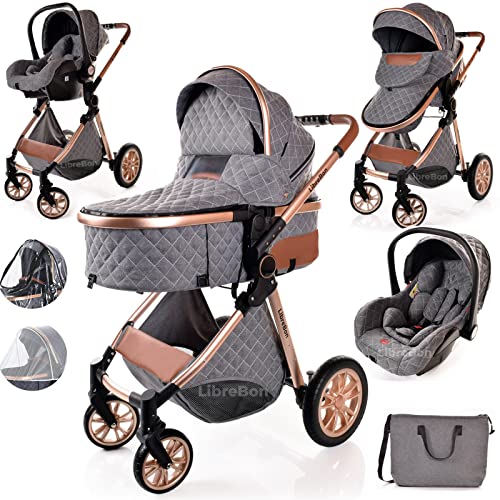How To Create Successful Prams And Pushchairs For Newborns Tutorials On Home
Prams and Pushchairs for Newborns: A Comprehensive Guide
When it pertains to getting ready for a brand-new baby, selecting the ideal pram or pushchair is a vital job for expectant moms and dads. With a myriad of alternatives available, making an informed choice is vital for both security and benefit. This post intends to provide comprehensive insights into prams and pushchairs, concentrating on the special requirements of newborns.
Understanding Prams and Pushchairs
Before diving into specifics, it is important to clarify the differences between prams and pushchairs.
Prams: Typically created for infants, prams have a flat, fully reclined position suitable for newborns. They frequently feature a big canopy and a carrycot, which supplies a safe and comfy area for the baby.
Pushchairs: These are more flexible and can generally be adapted to accommodate growing children. Modern pushchairs often have convertible seating options, allowing for an upright or reclined position, but they may not appropriate for newborns without extra assistance.
Both options are created to supply convenience for the kid and convenience for the caretaker, but picking the best one depends upon different aspects.
Factors to Consider When Choosing a Pram or Pushchair for Newborns
Picking a pram or pushchair involves evaluating a number of important aspects:
Safety Standards: Prioritize products that meet national and worldwide safety standards. Try to find functions such as secure harness systems, tough frames, and the absence of harmful materials.
Comfort: A well-padded seat and adjustable reclining positions are vital for a newborn's convenience. The padding ought to be soft and breathable to prevent overheating.
Weight and Portability: For ease of usage, think about the weight of the pram or pushchair. Lightweight designs are easier to navigate and store, however ensure they don't compromise on stability.
Versatility: Many prams and pushchairs are developed to adjust as your child grows. Some models can transform from a pram to a pushchair and consist of cars and truck seat attachments.
Storage Capacity: Check for a basket or storage compartment to accommodate diaper bags and other fundamentals. Adequate storage is particularly essential for getaways.
Maneuverability: A good pram or pushchair ought to be simple to steer and browse in tight areas. Try to find features such as swivel wheels that accommodate turns and uneven surface areas.
Weather Protection: A sunshade or rain cover is helpful to safeguard your baby from unfavorable weather condition conditions. Ensure these features are easy to deploy and retract.
Design and Design: While functionality is the primary concern, lots of parents appreciate stylish designs. Select a color and fabric that matches your individual taste.
Kinds of Prams and Pushchairs
Here is a breakdown of typical types of prams and pushchairs offered on the marketplace:
Type
Description
Suitable For
Traditional Prams
Carrycot style with a focus on convenience and safety for babies.
Newborns approximately 6 months
Travel Systems
Combines a stroller with an automobile seat for smooth transitions.
Parents on-the-go
Light-weight Strollers
Compact and simple to fold, appropriate for city residents.
Taking a trip families
Jogging Strollers
Designed with durable wheels for easy maneuvering on numerous surfaces.
Active households
Convertible Strollers
Adapts from a pram to a stroller as the baby grows.
Long-term use
Top Recommended Prams and Pushchairs for Newborns
Choosing from readily available choices can be intimidating. Here are some popular models that consistently get full marks:
- Bugaboo Bee5: Known for its exceptional maneuverability and lightweight frame.
- Silver Cross Wave: A top quality, flexible option that can transform as your baby grows.
- Uppababy Vista: Offers extensive storage and can accommodate several children as a stroller.
- Chicco Bravo Quick-Fold: Features a simple one-hand fold and appropriates for newborns when utilized with a compatible safety seat.
- Baby Jogger City Mini GT2: Combines robust functions with portability for active households.
Frequently asked questions
**Q: What is the difference between a carrycot and a pushchair seat? Prams Pushchairs UK : A carrycot is flat and designed specifically for newborns, enabling them to lie flat, whereas a pushchair seat is normally more upright and can be adjusted. Q: At what age can my baby shift
from a pram to a pushchair?A: Generally, babies can transition to a pushchair when they can sit up unassisted, generally around 6 months old, but constantly describe the maker's standards. Q: Are there prams and pushchairs that use cars and truck seat compatibility?A: Yes, lots of travel systems provide compatibility with baby car seats, making it simple to shift from automobile to pram without troubling your baby. Q: How frequently need to I inspect safety features?A: Regularly examine harness systems, wheel locks, and the frame for wear or damage to guarantee ongoing safety for your kid
**. Q: What must I try to find in regards to service warranty and support?A: Choose a pram or pushchair that offers a substantial guarantee period, which can differ from brand name to brand, and inspect for consumer
**assistance options in case of concerns. Selecting the ideal pram or
pushchair for a newborn is a decision that requires cautious thought and consideration. Comprehending the distinctions between prams and pushchairs, examining their functions, and comparing
numerous designs empower parents to make the very best option for their little one. By investing time in research and referencing the info offered, brand-new parents can ensure that their baby experiences convenience and security throughout their getaways, leading the way for enjoyable experiences together in the years to come.  ******
******